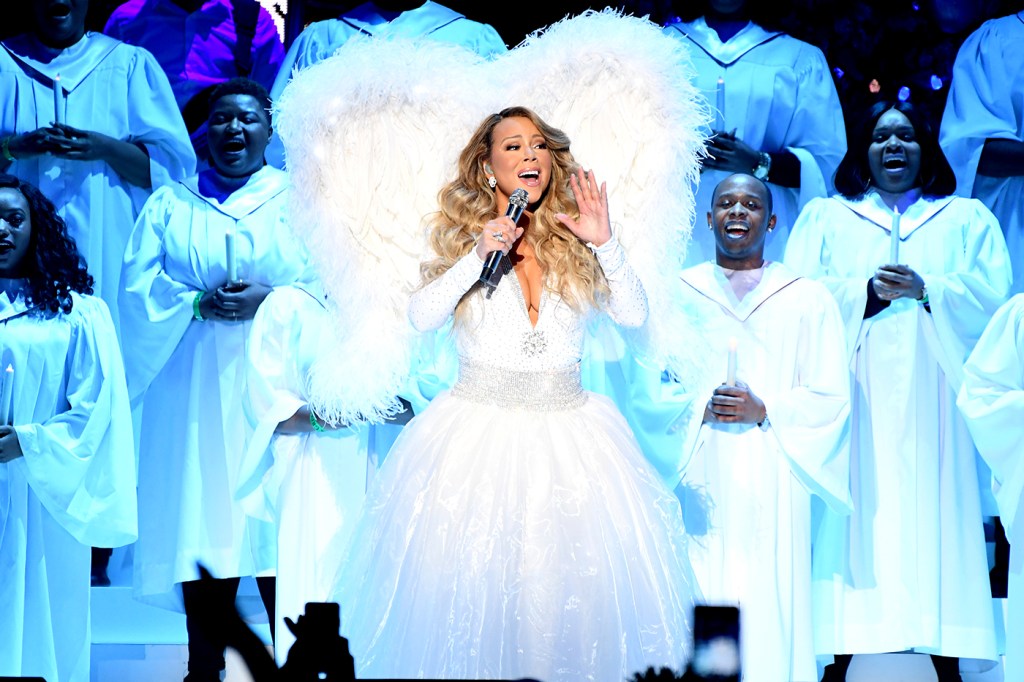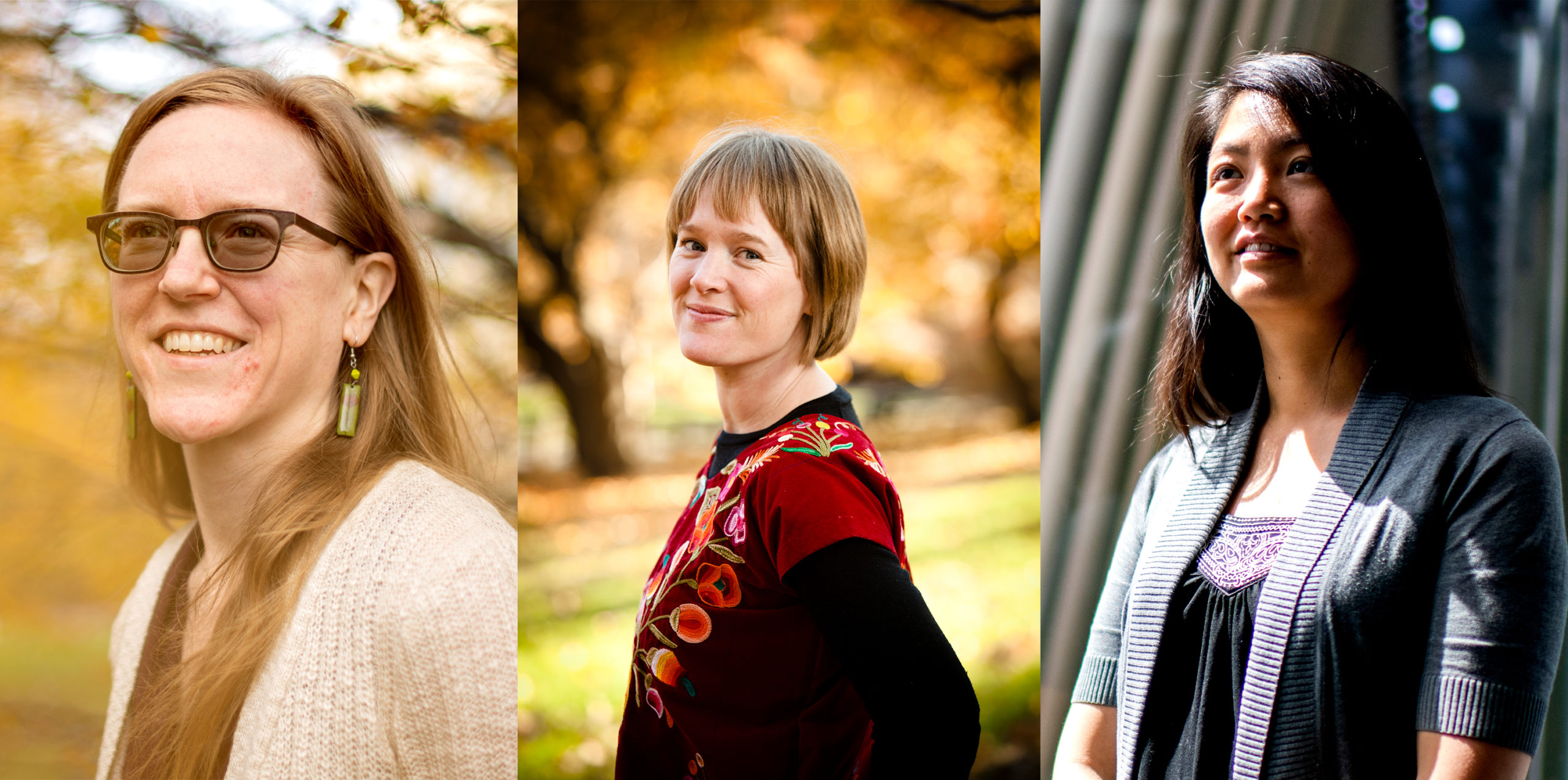Why do you love (or hate) holiday music?

The season is upon us and there is no escaping it.
“The Christmas Song” greets us at warmly lit restaurants.
“White Christmas” follows us down the supermarket bread aisle.
“Grandma Got Run Over by a Reindeer” stupefies us everywhere.
What makes holiday music so unavoidably popular year after year? Why do so many people love it—and so many others detest it?
It has to do with nostalgia, say Northeastern faculty experts.
“There’s this wonderful classic finding called the reminiscence bump that is especially true in music,” says Psyche Loui, a Northeastern associate professor of creativity and creative practice as well as director of the Music, Imaging, and Neural Dynamics (MIND) Lab, which researches the networks of brain structure and function that enable people to process music.

Left to right: Deirdre Loughridge, associate professor of music; Anne Hege, assistant adjunct professor of music at Mills College; and Psyche Loui, associate professor of creativity and creative practice and director of the Music, Imaging, and Neural Dynamics (MIND) Lab. Photos by Matthew Modoono/Northeastern University and courtesy photo.
“The music that evokes the most autobiographical memories tends to be music that we first hear in adolescence and early adulthood,” Loui says. “So if you think about the music that you’re particularly likely to fall back on, they’re most likely to be from your late teenage years or your early 20s. That’s a remarkable and consistent result that tells us something about how our brains develop in life and how our emotions and our memories mature.”
The most popular Christmas songs seem to have been around forever. A 2019 analysis by The Washington Post showed that 22 of the 23 most popular holiday songs were released in the previous century—the exception being a 2011 Michael Bublé cover of “It’s Beginning to Look a Lot Like Christmas,” originally written in 1951.
“I’m an unqualified fan of Christmas music,” says Deirdre Loughridge, a Northeastern associate professor of music who writes songs and plays the cello. “One of the things I like about it is how these songs connect you back to previous holidays and times with family. It’s a way of connecting with memories.”
The allure of warm memories also accounts for the enduring popularity of “It’s a Wonderful Life,” “A Charlie Brown Christmas,” and “Rudolph the Red-Nosed Reindeer” (the 1964 animated version starring Hermey the Elf and Yukon Cornelius).
“I grew up listening to a Billboard Christmas hits album from the ‘50s and ‘60s,” says Loughridge. “I also enjoy the Muppets versions of Christmas songs.”
Loughridge appreciates how modern-day artists reinterpret holiday classics. A 2020 Grammy-nominated arrangement of “The Christmas Song” by Jacob Collier has become Loui’s favorite holiday piece.
“The song evokes that cold winter feeling,” Loui says. “It’s funny, because I’m from Hong Kong originally, and so I’d never seen chestnuts roasting on an open fire or a white Christmas until I was in my teenage years—but I still formed that association. Maybe that is some evidence for the reminiscence bump: I moved to a new place that had cold winters in my early teenage years, just in time to form those formative memories.”
Anne Hege, a composer and assistant adjunct professor of music at Mills College, appreciates how the holidays enable traditional genres to emerge in public settings.
“You have people listening to choral music who wouldn’t normally,” says Hege, who directs choirs. “There’s a blurring of lines that is nice.”
Hege finds that her 4-year-old twins react instinctively by dancing to the music of “The Nutcracker,” even though they’ve never seen its balletic production. She and her husband add to the family mystique by pulling out old vinyl Christmas records from their childhood to play this time of year.
“The record player was broken maybe three months ago,” Hege says. “It had to be fixed by December because it would be a much better holiday if it were usable.”
Holiday songs encourage family and friends to sing, eliciting harmonies rarely heard apart from birthday celebrations.
“I was raised as a choral singer, and I love that it gives people an opportunity to sing together,” Hege says. “It’s one of the only times of year when people burst into song.”
“I enjoy singing ‘Deck the Halls’ because fa la la, la la la, la la la is just so fun,” Loughridge says. “Last year, in lieu of a Christmas card, we did a cover of ‘Have Yourself a Merry Little Christmas,’ my husband and I. We also did a short ‘Jingle Bells’ with our kids (ages 8, 6, and 1), and our 8-year-old played the drums on it.”
The COVID-19 era has deepened associations with holiday music.
“It happened last year in particular as a pandemic holiday,” Loughridge says. “Songs that had those ‘I’ll be home’ or ‘I won’t be home’ messages in them, many of which came from war-time eras when that was a very common experience—that seemed to be a subgenre of Christmas music.”
The endless playing of Christmas classics for commercial purposes at shopping malls can be grating, though Hege notes the desire to avoid public settings during the pandemic may be lessening the cases of music fatigue. But there is no changing this outcome: As much as some people love holiday music, others hate it with equal intensity—both for the same reasons, says Loui.
“I enjoy it up to a certain point, and then I have to listen to something else,” Loui says. “When we’re listening to music, we’re always finding associations between the sounds and our long-term memories. And we’re also forming expectations for how the sounds are going to unfold as they’re happening moment by moment. So I think there’s multiple levels of memory learning and associations that are at play.
“Holiday music scratches a lot of that,” adds Loui. “At some point, though, our brains also need novelty. And maybe that’s the part where hearing that same song over and over again might be a little bit boring. So it’s that push-pull between wanting to hear holiday music and not wanting to hear holiday music.”
For 11 months per year, popular music embraces the fresh and the new. For the next few weeks, however, we are all going to be leaning back to the days gone by.
“We tend to think of time linearly and always moving forward,” Loughridge says. “But there is this cyclical aspect of time as well, and the coming back of holiday music is an experience of that.”
For media inquiries, please contact media@northeastern.edu.






